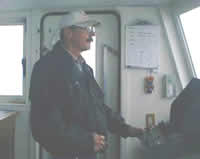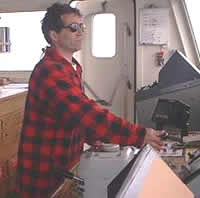| |
| |

Captain Dan Arnsdorf at the helm of the
R/V Wecoma.

Chief Mate Rick Verlini taking control
of the R/V Wecoma.
|
|
Teacher Logbook - R/V Wecoma
Missy
Holzer 's Sealog:
CTD Cruise Day 11
Weather at 1630 hours PDT:
Overcast skies with winds of 21 knots from
the
northwest, and visibility of 10 miles. Barometric pressure is 1027.2,
and
the temperature is 57 degrees Fahrenheit. Ocean swells are 5 feet out
of
the northwest, and the seas are 6 feet out of the northwest.
Today finds
us in the midst of a tow-yo after about 6 hours of steaming to our new
location - the Cleft segment of the Juan de Fuca Ridge. Keeping the R/V
Wecoma in a straight path during a tow depends on the expertise of the
crew at the helm where they employ state of the art technology in maintaining
an accurate position while the NeMO CTD cruise is underway.
Whether it's
the Captain, the 2nd Mate, or the Chief Mate, the crewmember at the helm
takes full charge of the ship while on they are on their watch. At the
helm, safe navigation is their first objective along with the safety of
the vessel and the crew. Captain Dan Arnsdorf works closely to ensure
that the Chief Scientist meets his/her science objectives while on the
ship by controlling and maintaining the position of the ship while the
science is being performed. Maintaining the position of a ship in this
vast expanse we're sailing in has changed over time: from the use of celestial
navigation (the use of the position of celestial objects to find a position
on land), to the use of signals sent to land and back to sea, to the current
use of GPS (Global Positioning System). Since the onset of GPS, the ship
always knows where it's at, whereas before GPS, the confirmation of a
position was determined after receiving a signal from the shore sometimes
just 4 times a day. To aid those at the helm even further, computer charting
programs that work in conjunction with GPS plot the ship's course and
helps it maintain its position with accuracy to 3 decimal places in latitude
and longitude. This is an asset to a scientist like Dr. Baker who relies
on accuracy in the ship's position to aid his work in locating hydrothermal
activity. The use of technology in navigation doesn't mean that those
wanting to take the helm don't have to learn how use the position of the
stars and sun to navigate the ocean waters. On the contrary, proficiency
in celestial navigation is necessary should the unfortunate need arise
where it's the only method to guide a ship to safety.
The Captain
or whoever else has the helm is the first person notified of any activity
on the ship where safety is involved. When the "fish" is deployed
or if the door to the fantail needs to remain open while instruments are
moved in and out of the ship, permission must be acquired from the Bridge
first, and at the conclusion of the activity, the Bridge must notified
again. Rough seas can be detrimental to oceanographic equipment, especially
while deploying and recovering, so the Captain and the Chief Scientist
are constantly dialoguing to ensure that safety is maintained at all costs,
even if means postponing a cast or tow-yo until the waters are calmer.
Fortunately for the NeMO CTD Cruise the summer waters in this area are
usually the calmest of the year, and fortunate for the crew and staff
on board, we are under the watchful eyes of those at the helm of the R/V
Wecoma.
|
|

